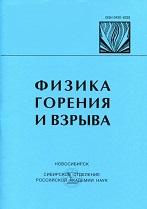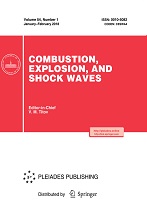|
This article is cited in 13 scientific papers (total in 13 papers)
Formation of metal oxide nanoparticles in combustion of titanium and aluminum droplets
V. V. Karaseva, A. A. Onischuka, S. A. Khromovaa, O. G. Glotova, V. E. Zarkoa, E. A. Pilyuginaa, Ch.-J. Tsaib
a Institute of Chemical Kinetics and Combustion, Siberian Division, Russian Academy of Sciences, Novosibirsk, 630090
b Institute of Environmental Engineering, National Chiao Tung University, Hsinchu, 300, Taiwan
Abstract:
A study was performed of the formation of metal oxide nanoparticles during combustion of aluminum and titanium drops which moved in air at a velocity of up to 3 m/sec. The source of the burning particles was a pyrotechnic mixture which contained an oxidizer, a binder, and metal particles of size 4–350 $\mu$m. Transmission electron microscopic studies showed that the combustion products were 1–10 $\mu$m aggregates of fractal structure consisting of primary particles (spherules) of Al$_2$O$_3$/TiO$_2$ 5–150 nm in diameter. The Brownian diffusion of the aggregates and their motion in electric and gravitational fields were observed using videomicroscopic recording. The charge distribution of TiO$_2$ aggregates and the equivalent radius of Brownian mobility were determined. In Al combustion, the zone of nanoparticle formation is separated from the particle surface by a distance approximately equal to the particle radius, and in Ti combustion, this zone is located directly near the surface. Coagulation of the oxide aerosol in the track of a burning particle leads to aerogelation with the formation of huge aggregates. Analytical expressions for approximate calculation of the parameters of the oxide particles and zones of their formation are proposed.
Keywords:
particle burning, aluminum, titanium, oxide formation, nanoparticles, spherules, aggregates, morphology, mobility, charge, fractal dimension.
Received: 28.06.2006
Citation:
V. V. Karasev, A. A. Onischuk, S. A. Khromova, O. G. Glotov, V. E. Zarko, E. A. Pilyugina, Ch.-J. Tsai, “Formation of metal oxide nanoparticles in combustion of titanium and aluminum droplets”, Fizika Goreniya i Vzryva, 42:6 (2006), 33–47; Combustion, Explosion and Shock Waves, 42:6 (2006), 649–662
Linking options:
https://www.mathnet.ru/eng/fgv1639 https://www.mathnet.ru/eng/fgv/v42/i6/p33
|


| Statistics & downloads: |
| Abstract page: | 28 |
|





 Contact us:
Contact us: Terms of Use
Terms of Use
 Registration to the website
Registration to the website Logotypes
Logotypes








 Citation in format
Citation in format 
